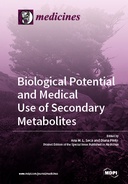Explore

Biological Potential and Medical Use of Secondary Metabolites
Ana M. L Seca and Diana Cláudia Pinto
2019
1 Ungluer has
Faved this Work
Login to Fave
Many macro and micro species, from terrestrial and aquatic environments, produce structurally unique compounds and, in many countries, still are the primary sources of medicines. In fact, secondary metabolites are an important source of chemotherapeutic agents but are also lead compounds for synthetic modification and the optimization of biological activity. Therefore, the exploitation of secondary metabolites, or their inspired synthetic compounds, offers excellent opportunities for the pharmaceutical industry. This Medicines Special Issue focuses on the great potential of secondary metabolites for therapeutic application. The Special Issue contains 16 articles reporting relevant experimental results, and an overview of bioactive secondary metabolites, their biological effects, and new methodologies that improve and accelerate the process of obtained lead compounds with regard to new drug development. We would like to thank all 83 authors, from all over the world, for their valuable contributions to this Special Issue.
This book is included in DOAB.
Why read this book? Have your say.
You must be logged in to comment.
Rights Information
Are you the author or publisher of this work? If so, you can claim it as yours by registering as an Unglue.it rights holder.Downloads
This work has been downloaded 440 times via unglue.it ebook links.
- 251 - pdf (CC BY-NC-ND) at Unglue.it.
Keywords
- (-)-rabdosiin
- ABTS
- amentoflavone
- Analysis
- analytical determination
- ancient varieties
- anti-inflammatory
- antibacterial
- anticancer
- antimicrobial activity
- antimicrobial and anticancer activity
- antioxidant
- antioxidant activity
- Antioxidants
- antiplasmodial
- antiSMASH
- antitumor
- Artemisia species
- Artemisia vachanica
- artemisinin
- ascorbic acid
- biological activities
- biosynthetic gene clusters
- Boswellia
- boswellic acids
- bowel diseases
- Cannabinoids
- Cannabis
- Celastraceae
- cembranoids
- cneorubenoids
- cordycepin
- Cordyceps militaris
- Cytotoxic
- cytotoxic activity
- defensins
- deoxypodophyllotoxin
- diterpenes
- DPPH
- EGCG
- essential oils
- Flavonoids
- frankincense
- FRAP
- GC-MS
- HPLC-PAD
- HPLC-PDA
- infectious diseases
- Inflammation
- innate immunity
- iridoids
- Juniperus
- kratom
- Lamiaceae
- LC-MS/MS
- legalization
- lignans
- Malaria
- Malus x domestica
- Maytenus chiapensis
- medicinal applications
- medicine
- Mitragyna speciosa
- molecular docking
- nanoemulsion
- Natural Products
- nutraceutics
- Ocimum sanctum
- pectin
- pentacyclic triterpenoids
- phenolic derivatives
- phytochemistry
- plant defense
- Plants
- Polyphenols
- PPAR-?
- pristimerin
- quinonemethide triterpenoids
- sargachromenoic acid
- sargahydroquinoic acid
- sarganaphthoquinoic acid
- sargaquinoic acid
- Scabiosa
- seaweeds
- secondary metabolites
- Sugars
- Tajikistan
- TCM
- therapeutic uses
- Therapeutics
- tingenone
- total phenolics
- Toxicology
- triterpenoids
- Tuscany
- Vector control
- xanthine oxidase
Links
DOI: 10.3390/books978-3-03921-188-3Editions


